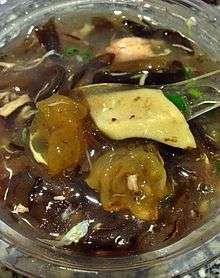Imitation shark fin soup

Imitation shark fin soup (碗仔翅), also known as wun tsai chi in Cantonese (literally fin in a little bowl), is one of Hong Kong's common street snacks, usually sold in small bowls by street vendors. Imitation shark fin soup is a staple of Hong Kong's street vendor cuisine.
It’s somewhat of a substitution for the real shark fin soup, as the genuine article tends to be more expensive due to its ingredients. Since there is a rising concern on shark finning as it is considered cruel by the general public,[1] imitation shark fin soup is a shark-friendly, vegetarian alternative, as it contains no shark fin, only bean noodles. One Taiwanese manufacturer's recipe for imitation shark fin contains water, gelatin, alginic acid, sugar, casein, and triolein to imitate real shark fin's chewy, gelatinous texture. In addition, people uses konjac as substitute for shark fins as well.[2][3]
History

Imitation shark fin soup originated from Temple Street in Hong Kong during the 1950s and '60s.[4] People at that time could not afford to eat real shark fins, therefore, the street vendors collected the broken parts of shark fins in the food waste dumped by Chinese restaurants, cooked them with mushrooms, egg, and pork, as well as soy sauce and other ingredients. Cooking the mixture into a soup, it was served in a small bowl. This soup was inexpensive and lacked the authentic flavour but since it was cheap, tasty and contained lots of ingredients, it was popular among the poor and became one of the famous street-side snacks in Hong Kong.
Apart from the street-side in Hong Kong, imitation shark fin soup may also be found in fast food stores, expensive Chinese restaurants or even on mainland China.
Controversy
According to the news article, the Trade Descriptions Ordinance in Hong Kong, all false trade descriptions to goods and not services are prohibited.[5] Therefore, imitation shark fin soup is facing the challenge of changing its name since ‘wun tsai chi’ in Cantonese may mislead customers into thinking there is real shark fin in it. However, many Hong Kong people argue against this new policy. Some of them claimed that imitation shark fin soup is one of the Hong Kong people’s collective memories and represents the history of old Hong Kong. Hong Kong people used to call it as ‘wun tsai chi’. If the name were changed, it would be inconvenient for tourists as they may be unable to find imitation shark fin soup. As there are many oppositions towards it, some people also suggest that Hong Kong government should consider whether customers are misled on purpose or not before carrying out the policy in order to act as a deterrent while keep the local snacks culture.
References
- ↑ Shark Finning. Humane Society International.
- ↑ Kho, Kian (2015). Phoenix Claws and Jade Trees: Essential Techniques of Authentic Chinese Cooking. New York: Clarkson Potter. p. 278. ISBN 9780385344692.
- ↑ Kho, Kian. "Banning Shark Fins from Shark Fin Soup". Red Cook. Retrieved 5 September 2016.
- ↑ Better than the real thing: Hong Kong's imitation shark fin 27 May 2011. CNNGo.
- ↑ 食家憂碗仔翅留不住
External links
| Wikimedia Commons has media related to Vegetarian shark fin soup. |